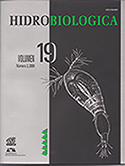Aquatic macrophytes tolerance to domestic wastewater and their efficiency in artificial wetlands under greenhouse conditions
Keywords:
Artificial wetlands, Eleocharis densa. Schoenoplectus tabernaemontani, Schoenoplectus americanusAbstract
Aquatic and semi-aquatic plant species of three different water qualities were inventoried, two of the El Tunal river and one of one of its tributaries, considering its content of dissolved oxygen, soluble phosphates, nitrate, ammonia, fecal coliforms, total suspended solids, and measurements of pH and electrical conductivity. A MANOVA/ANOVA demonstrated significant differences among parameters and sites. Twenty-eight species were identified; from them: Schoenoplectus americanus, S. tabernaemontani and Eleocharis densa were selected. All three were grown successfully under greenhouse conditions. Adaptation to local wastewater was evaluated using 5 micro-units: one control with wastewater (WW), another with gravel (G), and three sub-surface flow wetlands, one for each of the three selected plants, in duplicate. For ammonia and phosphate concentration, the systems with gravel removed 96 - 98%, and 99 - 100%, respectively. Fecal coliforms content was reduced about the same in all systems, 98.5 - 98.7%. No significant differences were found in removal of fecal coliforms and ammonia across time or among species. Removal of ions (98% in 48 h) was due mainly to the gravel used as support, for its ionic exchange capacity. Nonetheless, the three selected species are considered as appropriate for wetland construction because they are native, abundant, tolerant to local conditions, easy to propagate and establish, and highly tolerant to wastewater in their place of origin. Its dense growing habit would represent also a refuge for wildlife, another goal for constructing a wetland in the area.Downloads
Downloads
Published
How to Cite
Issue
Section
License
Los autores/as que publiquen en esta revista aceptan las siguientes condiciones:
De acuerdo con la legislación de derechos de autor, HIDROBIOLÓGICA reconoce y respeta el derecho moral de los autores, así como la titularidad del derecho patrimonial, el cual será cedido a la revista para su difusión en acceso abierto.
Publicar en la revista HIDROBIOLÓGICA tiene un costo de recuperación de $500 pesos mexicanos por página en blanco y negro (aproximadamente 29 dólares americanos) y $1000 pesos por página a color (aproximadamente 58 dólares americanos).
Todos los textos publicados por HIDROBIOLÓGICA sin excepción se distribuyen amparados bajo la licencia Creative Commons 4.0Atribución-No Comercial (CC BY-NC 4.0 Internacional), que permite a terceros utilizar lo publicado siempre que mencionen la autoría del trabajo y a la primera publicación en esta revista.
Los autores/as pueden realizar otros acuerdos contractuales independientes y adicionales para la distribución no exclusiva de la versión del artículo publicado en HIDROBIOLÓGICA (por ejemplo incluirlo en un repositorio institucional o publicarlo en un libro) siempre que indiquen claramente que el trabajo se publicó por primera vez en HIDROBIOLÓGICA.
Para todo lo anterior, el o los autor(es) deben remitir el formato de Carta-Cesión de la Propiedad de los Derechos de la primera publicación debidamente requisitado y firmado por el autor(es). Este formato se puede enviar por correo electrónico en archivo pdf al correo: enlacerebvistahidrobiológica@gmail.com; rehb@xanum.uam.mx (Carta-Cesión de Propiedad de Derechos de Autor).
Esta obra está bajo una licencia de Creative Commons Reconocimiento-No Comercial 4.0 Internacional.


